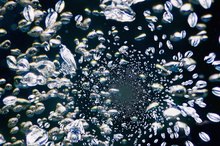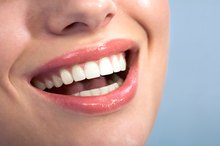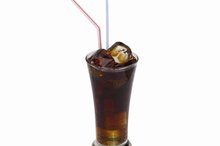How Can Soda Damage Your Bones?
If you're an average American, you drink around 45 gallons of soda and other sugary drinks every year, according to Kick the Can 1. Fast-food restaurants, sit-down restaurants, vending machines and so many other places all around are bursting at the seams with soda. Almost everyone knows that soda isn't a healthful drink, but you might not realize how much it can damage your health. Evidence backs up the detriments of this fizzy drink, and once you understand what it does to your bones, you might never look at soda the same way again.
Getting to Know Soda
Regular soda contains up to 11 teaspoons of sugar per can. The sugar causes your blood sugar to spike, which results in a release of insulin. Soda also contains phosphoric acid, and shortly after you take a drink, it hits your lower intestine and binds with magnesium, zinc and calcium. Instead of those minerals reaching your bones, you pass them out of your system when you urinate, leaving your body depleted. Diet and regular soda both contain high levels of phosphoric acid, so switching to the “healthier” variety isn't healthier after all.
- Regular soda contains up to 11 teaspoons of sugar per can.
- Diet and regular soda both contain high levels of phosphoric acid, so switching to the “healthier” variety isn't healthier after all.
Stealing from Your Bones
Pros & Cons of Soda & Soft Drinks
Learn More
The bone-depleting effect of soda might affect women and teens more than adult men, according to MedPage Today. Women who drink an average of six servings of soda per day for just six weeks could see a notable -- between 3 and 6 percent -- drop in their bone mineral density. The decrease in bone mineral density was lower with women who drank diet soda, but even diet versions still resulted in a notable decrease. Teenagers are at an even bigger risk when drinking soda. When nine of 10 teen girls and seven of 10 teen boys already aren't eating enough calcium, they can't afford to lose calcium to the phosphoric acid in soda 1. Teens whose bones don't get enough calcium have a higher risk of breaks, fractures and, later in life, osteoporosis.
- The bone-depleting effect of soda might affect women and teens more than adult men, according to MedPage Today.
- The decrease in bone mineral density was lower with women who drank diet soda, but even diet versions still resulted in a notable decrease.
Dissolving Your Teeth
Though your teeth technically aren't bones, they're composed of many of the same minerals. Teeth are stronger than bones, but they lack restorative properties. In other words, if you damage your teeth, they won't heal as a bone will. Drinking large quantities of soda can cause tooth deterioration in more ways than just depleting your body's minerals. According to the Academy of General Dentistry, regularly drinking soda can cause tooth erosion similar to that caused by illegal drugs 19. The damage results from the citric acid in regular and diet soda rather than from sugar.The acid damages your enamel and makes your teeth more vulnerable to rot. Depletion of minerals caused by drinking soda is just icing on the cake.
- Though your teeth technically aren't bones, they're composed of many of the same minerals.
- Drinking large quantities of soda can cause tooth deterioration in more ways than just depleting your body's minerals.
Choosing Healthier Drinks
Why Is Phosphoric Acid Bad for You?
Learn More
Instead of drinking soda, quench your thirst with something that supplies calcium instead of taking it away. Water supplies a small amount of calcium, hydrates your body and is the healthiest thing you can drink. Milk is another excellent option to nourish your body and provide a bit of calcium. Unsweetened tea and black coffee, provided you drink them in moderation, can also stand in as healthier alternatives to soda.
- Instead of drinking soda, quench your thirst with something that supplies calcium instead of taking it away.
- Water supplies a small amount of calcium, hydrates your body and is the healthiest thing you can drink.
Related Articles
References
- Harvard School of Public Health: How Sweet Is It?
- Lawrence Wilson, MD: Calcium
- MedPageToday: Carbonated Cola Drinks Drop Bone Density in Women
- Best Bones Forever: Bone Bandits
- LiveScience: Why Are Teeth Not Considered Bones?
- ScienceDaily: Soda and Illegal Drugs Cause Similar Damage to Teeth
- Laura Helm, Ian A. Macdonald, Impact of beverage intake on metabolic and cardiovascular health, Nutrition Reviews, Volume 73, Issue suppl_2, 1 September 2015, Pages 120–129, https://doi.org/10.1093/nutrit/nuv049
- Jiantao Ma, Caroline S. Fox, Paul F. Jacques, Elizabeth K. Speliotes, Udo Hoffmann, Caren E. Smith, Edward Saltzman, Nicola M. McKeown,Sugar-sweetened beverage, diet soda, and fatty liver disease in the Framingham Heart Study cohorts. Journal of Hepatology 63;2(2015). https://doi.org/10.1016/j.jhep.2015.03.032.
- Tooth. American Dental Association. https://www.mouthhealthy.org/en/az-topics/t/tooth.
- Coca-Cola Bottle, 12 fl oz. U.S. Department of Agriculture. Published February 27, 2020.
- 2015-2020 Dietary Guidelines for Americans. U.S. Department of Health and Human Services.
- How much sugar is too much? American Heart Association.
- Freeman CR, Zehra A, Ramirez V, Wiers CE, Volkow ND, Wang GJ. Impact of sugar on the body, brain, and behavior. Front Biosci (Landmark Ed). 2018;23:2255-2266. Published 2018 Jun 1.
- Pasiakos SM, McLellan TM, Lieberman HR. The effects of protein supplements on muscle mass, strength, and aerobic and anaerobic power in healthy adults: a systematic review. Sports Med. 2015;45(1):111-131. doi:10.1007/s40279-014-0242-2
- Blom WA, Lluch A, Stafleu A, et al. Effect of a high-protein breakfast on the postprandial ghrelin response. Am J Clin Nutr. 2006;83(2):211-220. doi:10.1093/ajcn/83.2.211
- Tipton KD. Nutritional Support for Exercise-Induced Injuries. Sports Med. 2015;45 Suppl 1:S93-S104. doi:10.1007/s40279-015-0398-4
- Kerstetter JE, Kenny AM, Insogna KL. Dietary protein and skeletal health: a review of recent human research. Curr Opin Lipidol. 2011;22(1):16-20. doi:10.1097/MOL.0b013e3283419441
- Paddon-Jones D, Short KR, Campbell WW, Volpi E, Wolfe RR. Role of dietary protein in the sarcopenia of aging. Am J Clin Nutr. 2008 May;87(5):1562S-1566S. doi: 10.1093/ajcn/87.5.1562S. PMID: 18469288.
- Maughan RJ, Griffin J. Caffeine ingestion and fluid balance: a review. J Hum Nutr Diet. 2003 Dec;16(6):411-20. doi: 10.1046/j.1365-277x.2003.00477.x. PMID: 19774754.
- Lete I, Allué J. The Effectiveness of Ginger in the Prevention of Nausea and Vomiting during Pregnancy and Chemotherapy. Integr Med Insights. 2016;11:11-17. Published 2016 Mar 31. doi:10.4137/IMI.S36273
- Laura Helm, Ian A. Macdonald, Impact of beverage intake on metabolic and cardiovascular health, Nutrition Reviews, Volume 73, Issue suppl_2, 1 September 2015, Pages 120–129,
- Ma J, Jacques PF, Meigs JB, et al. Sugar-Sweetened Beverage but Not Diet Soda Consumption Is Positively Associated with Progression of Insulin Resistance and Prediabetes. J Nutr. 2016;146(12):2544-2550. doi:10.3945/jn.116.234047
- Rippe JM, Angelopoulos TJ. Relationship between Added Sugars Consumption and Chronic Disease Risk Factors: Current Understanding. Nutrients. 2016;8(11):697. Published 2016 Nov 4. doi:10.3390/nu8110697
- Bucher Della Torre S, Keller A, Laure Depeyre J, Kruseman M. Sugar-Sweetened Beverages and Obesity Risk in Children and Adolescents: A Systematic Analysis on How Methodological Quality May Influence Conclusions. J Acad Nutr Diet. 2016;116(4):638-659. doi:10.1016/j.jand.2015.05.020
- Bray GA, Nielsen SJ, Popkin BM. Consumption of high-fructose corn syrup in beverages may play a role in the epidemic of obesity [published correction appears in Am J Clin Nutr. 2004 Oct;80(4):1090]. Am J Clin Nutr. 2004;79(4):537-543. doi:10.1093/ajcn/79.4.537
- Vartanian LR, Schwartz MB, Brownell KD. Effects of soft drink consumption on nutrition and health: a systematic review and meta-analysis. Am J Public Health. 2007;97(4):667-675. doi:10.2105/AJPH.2005.083782
- Pollock NK, Bundy V, Kanto W, et al. Greater fructose consumption is associated with cardiometabolic risk markers and visceral adiposity in adolescents [published correction appears in J Nutr. 2013 Jan;143(1):123]. J Nutr. 2012;142(2):251-257. doi:10.3945/jn.111.150219
- Elffers TW, de Mutsert R, Lamb HJ, et al. Body fat distribution, in particular visceral fat, is associated with cardiometabolic risk factors in obese women. PLoS One. 2017;12(9):e0185403. Published 2017 Sep 28. doi:10.1371/journal.pone.0185403
- Yudkin J. Sugar and ischaemic heart disease. Practitioner. 1967;198(187):680-683.
- Liu S, Willett WC, Stampfer MJ, et al. A prospective study of dietary glycemic load, carbohydrate intake, and risk of coronary heart disease in US women. Am J Clin Nutr. 2000;71(6):1455-1461. doi:10.1093/ajcn/71.6.1455
- Cohen L, Curhan G, Forman J. Association of sweetened beverage intake with incident hypertension. J Gen Intern Med. 2012;27(9):1127-1134. doi:10.1007/s11606-012-2069-6
- Welsh JA, Sharma A, Cunningham SA, Vos MB. Consumption of added sugars and indicators of cardiovascular disease risk among US adolescents. Circulation. 2011;123(3):249-257. doi:10.1161/CIRCULATIONAHA.110.972166
- Assy N, Nasser G, Kamayse I, et al. Soft drink consumption linked with fatty liver in the absence of traditional risk factors. Can J Gastroenterol. 2008;22(10):811-816. doi:10.1155/2008/810961
- Jiantao Ma, Caroline S. Fox, Paul F. Jacques, Elizabeth K. Speliotes, Udo Hoffmann, Caren E. Smith, Edward Saltzman, Nicola M. McKeown,Sugar-sweetened beverage, diet soda, and fatty liver disease in the Framingham Heart Study cohorts. Journal of Hepatology 63;2(2015).
- Avena NM, Bocarsly ME, Hoebel BG. Animal models of sugar and fat bingeing: relationship to food addiction and increased body weight. Methods Mol Biol. 2012;829:351-365. doi:10.1007/978-1-61779-458-2_23
- Avena NM, Rada P, Hoebel BG. Evidence for sugar addiction: behavioral and neurochemical effects of intermittent, excessive sugar intake. Neurosci Biobehav Rev. 2008;32(1):20-39. doi:10.1016/j.neubiorev.2007.04.019
- Choi HK, Willett W, Curhan G. Fructose-rich beverages and risk of gout in women. JAMA. 2010;304(20):2270-2278. doi:10.1001/jama.2010.1638
- Choi HK, Curhan G. Soft drinks, fructose consumption, and the risk of gout in men: prospective cohort study. BMJ. 2008;336(7639):309-312. doi:10.1136/bmj.39449.819271.BE
- Jamnik J, Rehman S, Blanco Mejia S, et al. Fructose intake and risk of gout and hyperuricemia: a systematic review and meta-analysis of prospective cohort studies. BMJ Open. 2016;6(10):e013191. Published 2016 Oct 3. doi:10.1136/bmjopen-2016-013191
- Tooth. American Dental Association.
- Cheng R, Yang H, Shao MY, Hu T, Zhou XD. Dental erosion and severe tooth decay related to soft drinks: a case report and literature review. J Zhejiang Univ Sci B. 2009;10(5):395-399. doi:10.1631/jzus.B0820245
- Hanover LM, White JS. Manufacturing, composition, and applications of fructose. Am J Clin Nutr. 1993;58(5 Suppl):724S-732S. doi:10.1093/ajcn/58.5.724S
- Meghan B. Azad, Ahmed M. Abou-Setta, Bhupendrasinh F. Chauhan, et al. Nonnutritive sweeteners and cardiometabolic health: a systematic review and meta-analysis of randomized controlled trials and prospective cohort studies. CMAJ Jul 2017, 189 (28) E929-E939; DOI: 10.1503/cmaj.161390
- Fowler, S.P., Williams, K., Resendez, R.G., Hunt, K.J., Hazuda, H.P. and Stern, M.P. (2008), Fueling the Obesity Epidemic? Artificially Sweetened Beverage Use and Long‐term Weight Gain. Obesity, 16: 1894-1900. doi:10.1038/oby.2008.284
- Fowler SP, Williams K, Hazuda HP. Diet soda intake is associated with long-term increases in waist circumference in a biethnic cohort of older adults: the San Antonio Longitudinal Study of Aging. J Am Geriatr Soc. 2015;63(4):708-715. doi:10.1111/jgs.13376
Writer Bio
Serena Styles is a Colorado-based writer who specializes in health, fitness and food. Speaking three languages and working on a fourth, Styles is pursuing a Bachelor's in Linguistics and preparing to travel the world. When Styles isn't writing, she can be found hiking, cooking or working as a certified nutritionist.








